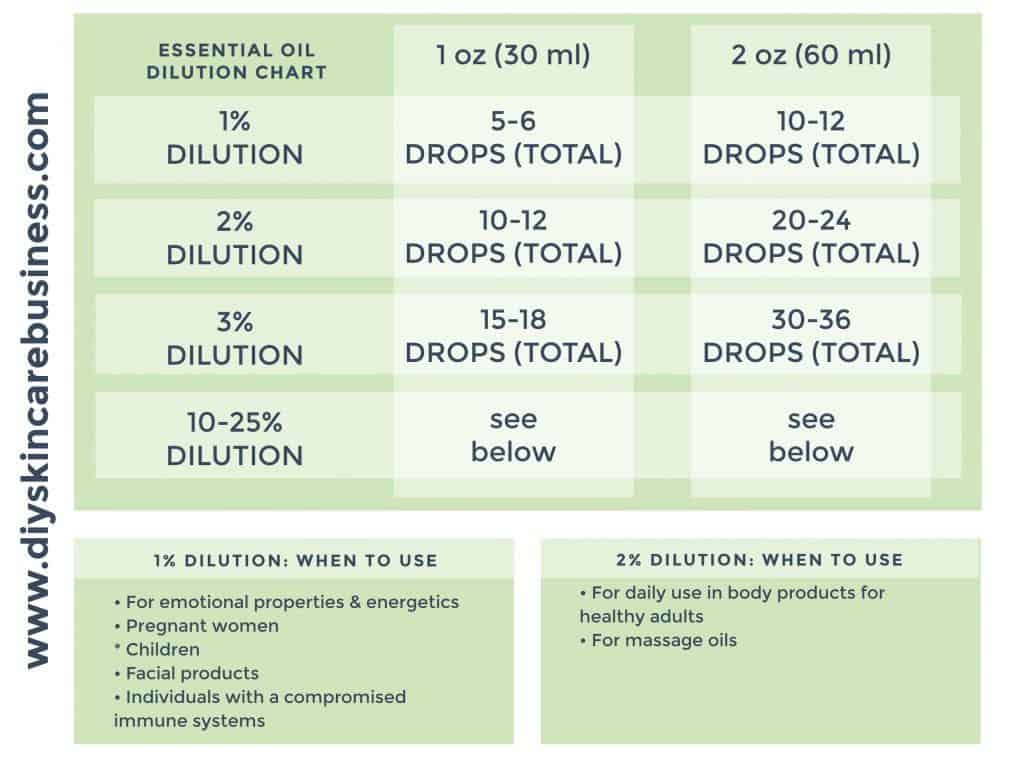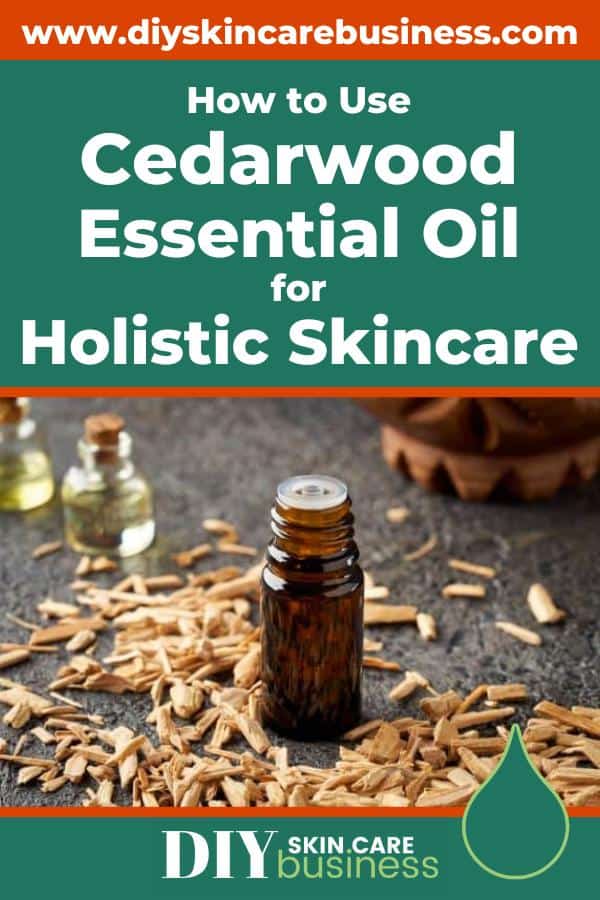Fresh, relaxing, and full of regenerating properties, cedarwood essential oil is a must-have in your holistic skincare toolkit (and formulas, for those of you that have a handmade business).
You know this scent, whether you know it or not. Freshly sharpened pencils, the inside of older trunks, cedarwood blocks you can purchase to freshen closets and drawers.
This well-known, dry aroma isn’t just for odor-neutralizing – its astringent and antiseptic qualities make it a key component in acne and first aid formulations.
Also used as a sedative, expectorant, and for stress management, cedarwood essential oil has so much potential for use in holistic wellness practices overall.
In this post, we’ll cover everything you need to know about cedarwood and some simple recipes you can make at home!

This post may contain affiliate links, meaning I get a commission if you decide to make a purchase through my links (at no cost to you). Please read the disclosure for more information.
Cedarwood Essential Oil Profile
- Latin name: Juniperus virginiana
- Botanical family: Cupressaceae
- Plant part: Wood
- Countries of origin: USA
- Extraction method: Steam distilled
- Aroma descriptors: Earthy, fresh, dry, balsamic

A Bit of Cedarwood Essential Oil Chemistry
All essential oils are made up of hundreds of tiny molecules, and the variations from one to another are what change their aroma, use, and safety precautions.
Some of these molecules are in tiny percentages, whereas some are so large in number that they dominate the overall behavior (or ‘personality’) of the oil.
Cedarwood (Juniperus virginiana) is highest in components a-Cedrene at 23.04% and a-Cedrol at 19.43% (see red highlights below), which are in the sesquiterpene and sesquiterpenic alcohol (sesquiterpenol) chemical families.
These percentages are *significant when compared to other constituents present in cedarwood essential oil.

The Sesquiterpene Chemical Family
In vitro research supports that in general, oils in the sesquiterpene chemical family tend to be:
- anti-inflammatory, antibacterial, antiseptic, analgesic, antispasmodic
The Sesquiterpenol Chemical Family
In vitro research supports that in general, oils in the sesquiterpenol chemical family are considered to be:
- grounding, sedative, skin-healing, immune-supportive, anti-inflammatory
Why Does Cedarwood’s Chemical Family Matter?
To be straight, you don’t need to memorize the chemistry notes above to formulate blends with cedarwood (nor should you, as these are generalities and the components can change from batch to batch).
This quick peek simply gives you the science-backed WHY behind using cedarwood essential oil for HOLISTIC skincare.
In the descriptions of sesquiterpene and sesquiterpenol components above, notice the range of observed therapeutic activity:
- Anti-inflammatory (can help alleviate inflammation)
- Grounding and sedative (promoting calm and/or sleep, emotionally rooted)
- Skin-healing and antibacterial (most specifically for eczema and acne)
We will use these characteristics to help guide our intentions for holistic skincare in the recipe section!
To get more of an explanation of essential oil chemistry, visit our post, 27 Best Essential Oils for Natural Skin Care Recipes.

Download Your Free Essential Oil List and Dilution Chart!
Safety Information for Using Cedarwood Essential Oil
Essential oils are incredibly concentrated, and you MUST dilute them with carrier oils rather than using them directly on the skin.
Using essential oils ‘neat’ (without dilution) can cause serious skin reactions that vary from person to person.
Shelf Life
Cedarwood essential oil has a long shelf life (when compared to other essential oils) of 6-8 years, thanks to its molecular size.
Sesquiterpene-rich oils (the prominent chemical family of cedarwood) are made up of 15 total carbon atoms. Compared to citrus oils (monoterpenes) that have 10 carbon atoms, this is much larger.
This size difference means that sesquiterpene-rich essential oils evaporate more slowly, have longer-lasting aromas (generally base notes), and have a longer shelf life.
Of course, this is assuming your bottle has been tightly sealed in a dark bottle, stored in a cool environment, and away from direct sunlight.
Cedarwood Essential Oil Dilution Rates
Cedarwood is a non-toxic, non-irritating essential oil, yet it still must be used safely to avoid skin reactions.
To safely dilute it to the percentages noted in the chart below, add the appropriate number of drops of cedarwood essential oil to a carrier oil (such as jojoba or grapeseed oil) and/or melted butters and waxes such as shea butter or mango butter.

Using Cedarwood Essential Oil When Pregnant or Nursing
It has been advised to NOT use cedarwood essential oil when pregnant or nursing, yet no evidence has been found to support this statement when using Juniperus virginiana.
When dealing with any approved essential oil during these times, adhere to the following safety notes:
- Avoid essential oils during the first trimester.
- During the second and third trimesters, pregnancy-safe essential oils may be used for support at a 1% dilution.
- Avoid using essential oils on a daily basis while pregnant.
- Use essential oils under the guidance of an aromatherapist or midwife.
Cedarwood Essential Oil and Children
Cedarwood essential oil can be used on/around children, but the following safety parameters with all essential oils should be followed:
- No essential oils should be applied to the skin of children 5 years old or younger.
- Stick to a 1% dilution for topical use on children 5-12 years old.

Cedarwood Essential Oil and Holistic Skincare
Holistic health considers the treatment of the whole person, taking into account any mental, social, and physical factors rather than just the immediate symptom(s) at hand.
If you are a holistic skincare entrepreneur, you’ll want to communicate to your customer that all of the details below contribute to the health and appearance of their skin:
- Hydration throughout the day
- Getting enough sleep
- Appropriate stress management
- Eating healthfully
- Exercising regularly
- Addressing any physical pain or discomfort
- Breathwork (taking deep belly breaths vs. short/shallow breaths)
If you are a handmade skin care entrepreneur, read more about the connection between holistic health and indie skin care here.
Mental Wellness and Cedarwood Essential Oil
As a base note, cedarwood essential oil is soothing and grounding, which is helpful when managing stress, anxiety, and insomnia.
This power to improve mindset shows through on the skin, as less stress helps your immune system to work its best.
Cedarwood is unique in its power to act as a sedative for the nervous system (while stimulating the respiratory system to deal with infections).
A more relaxed nervous system and mental state help individuals sleep better, be more inclined to exercise, and also make more mindful dietary decisions – all of which impact skin significantly.
Skin Care and Cedarwood Essential Oil
Cedarwood has different chemotypes based on where the tree is grown (chemotypes have different chemical makeups and how they work in and on our bodies). Because of this, it’s important to look at the Latin name to use the essential oil safely and intentionally.
Juniperus virginiana (from the North American Red Cedar tree) is best for skincare and its ability to rejuvenate skin cells.
This chemotype of cedarwood is also anti-inflammatory and antibacterial, which makes it a great choice for acne blends and healing salves for first-aid uses.
Cedarwood Essential Oil Wellness Recipes
Stress and Anxiety Body Oil
- 5 drops Cedarwood (Juniperus virginiana)
- 3 drops Grapefruit (Citrus paradisi)
- 2 drops Bergamot (Citrus bergamia)
- 2 drops Jasmine absolute (Jasminum grandiflorum)
- 1 drop Ylang Ylang (Cananga odorata var. genuina)
- 1 oz carrier oil (*maker’s choice)
Immune Support Diffuser Blend
- 4 drops Cedarwood (Juniperus virginiana)
- 4 drops Lemon (Citrus limon)
- 2 drops Cypress (Cupressus sempervirens)
- 2 drops Juniper Berry (Juniperus communis)
- 2 drops Siberian Fir (Abies sibirica)
Cuticle Repair Oil
- 3 drops Cedarwood (Juniperus virginiana)
- 3 drops Helichrysum (Helichrysum italicum)
- 3 drops Lavender (Lavandula angustifolia)
- 2 drops Patchouli (Pogostemon cablin)
- 1 oz carrier oil (*maker’s choice)
Great Outdoors Oil (for bugs)
- 5 drops Cedarwood (Juniperus virginiana)
- 4 drops Myrrh (Commiphora myrrha)
- 4 drops Patchouli (Pogostemon cablin)
- 3 drops Eucalyptus (Eucalyptus globulus)
- 2 drops Spike Lavender (Lavandula latifolia)
- 1 oz carrier oil (*maker’s choice)
A Note About Blending with Cedarwood Essential Oil
As discussed above, Cedarwood essential oil is a thicker, heavier oil (it has a 15-carbon backbone), meaning it sits on top of the skin for longer before absorbing than thinner oils.
This makes cedarwood fabulous for topical skin care and healing, and should also make you pause to consider the product you are making and its intention.
For example, if you are formulating a facial serum that you want to absorb more quickly, blend with essential oils that are lighter and smaller (in the monoterpene or monoterpenol chemical family), such as cypress (Cupressus sempervirens) or juniper berry (Juniperus communis).
If you are formulating a healing salve that should sit on top of the skin for longer, you may decide to blend with other heavy sesquiterpene/sesquiterpenol oils such as patchouli (Pogostemon cablin) or vetiver (Vitiveria zizanioides).

Download Your Free Essential Oil List and Dilution Chart!
Best Supplier for Cedarwood Essential Oil
As a certified aromatherapist, Plant Therapy is my go-to essential oil supplier.
You can buy cedarwood essential oil in 10, 30, and 100 mL sizes, as well as in bulk sizes at 0.5 kg, 1 kg, and 5 kg.
Plant Therapy also carries several pre-made products that contain cedarwood essential oil if you’re not ready to formulate yet but want to experience the benefits of this lovely oil.

Enjoy using cedarwood essential oil for holistic skincare – formulating with a lens of complete body and mind wellness is an eye-opening experience.
Join us in our private FB Group at DIY Skin Care Biz Community to let us know what you formulate for yourself and/or your handmade business!
Grow Your Skin Care Business!
Browse through the resources below to boost your handmade business visibility and profitability!








